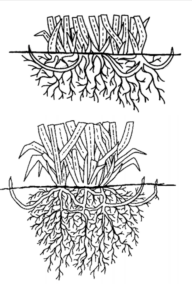Recycle Your Grass Clippings
W. M. Colt, R. Rynk, S. Bell, and W. J. Johnston
 Grass clippings have been banned from landfills by approximately half of the states in the United States and it may be only a matter of time before Idaho follows suit. Regardless of bans, however, there are no good reasons to collect and dispose of lawn grass clippings. In the collection system, grass clippings are a costly nuisance. Yet when recycled at home, grass clippings are a resource of valuable plant nutrients and organic matter for your soil. The best way to manage grass clippings is to leave them on the lawn. Grass clippings left to decompose (in place) will improve your turf. By following the steps in the “Don’t Bag It!” lawn care program you can have a healthy lawn while spending less time and less money maintaining it.
Grass clippings have been banned from landfills by approximately half of the states in the United States and it may be only a matter of time before Idaho follows suit. Regardless of bans, however, there are no good reasons to collect and dispose of lawn grass clippings. In the collection system, grass clippings are a costly nuisance. Yet when recycled at home, grass clippings are a resource of valuable plant nutrients and organic matter for your soil. The best way to manage grass clippings is to leave them on the lawn. Grass clippings left to decompose (in place) will improve your turf. By following the steps in the “Don’t Bag It!” lawn care program you can have a healthy lawn while spending less time and less money maintaining it.
Why Recycle Grass Clippings?
Grass clippings are too valuable to waste! When left on the lawn, properly mowed grass clippings filter down to the soil and decompose rapidly, usually within a few weeks. During the breakdown process, the clippings feed soil organisms, recycle plant nutrients, and contribute organic matter to the soil. As a result, water is conserved and less fertilizer is needed. Grass clippings contain about 4 percent nitrogen (N), 0.5 percent phosphorus (P), 2 percent potassium (K), plus small amounts of other plant nutrients. As much as 50 percent of the N that you apply as fertilizer is removed when grass clippings are collected. Research at the University of Missouri shows that grass clippings can supply 25 percent of a lawn’s total fertilizer needs. A study conducted by the University of Connecticut found that the N from grass clippings began showing up in the growing grass within 2 weeks. By the end of… Read More


